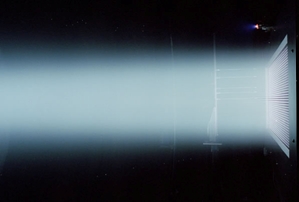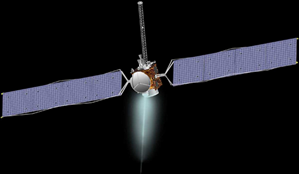Electrical ion propulsion and beyond
A talk with NASA’s Glenn Research Center engineer
Michael J. Patterson |
 |
For every action there is an equal and opposite reaction. Newton’s third law of motion is a fundamental behavior
of physics that forms the basis for all current space propulsion. For many scientists this wasn’t fully understood
when space travel was first contemplated, and they wondered how a vehicle could move in the vacuum of space without
anything to push against. An automobile moves forward because its wheels use the friction of contact to push
against the ground. An airplane flies because its propeller or jet thrust pushes against the surrounding air.
In space those conditions don’t exist and a vehicle can only move itself by pushing against the mass of its own
propellant.
In many ways the most modern rockets still operate similar to the ancient Chinese firework rockets dating back to
the 7th century, by oxidizing a fuel and exhausting the combustion products from one end. There’s a lot of exciting
science going on in this field, however, and electrical propulsion seems to own the future of space travel. I spoke
with electrical engineer Michael J. Patterson with NASA’s Glenn Research Center about this topic and the following is
transcribed from our conversation.
Q. When Robert Goddard developed the liquid fuel rocket, was the main advantage of it the ability to throttle, or
control the thrust?
Those are certainly attributes. When he developed the first liquid fuel rocket, and flew it in 1926, the motivation
behind liquid fuels was the higher energy density over solid propellants. It affords you a higher specific impulse,
which is really important because what we want to do is launch payloads off the Earth and not propellant. You need
high exhaust velocity to maximize the payload mass portion and that’s afforded by liquid propellants. It’s
certainly an advantage of liquid fuel rockets to be able to throttle the exhaust and reduce the dynamic pressure,
that’s what they do with the Space Shuttle, versus with solid-fuel rockets, once you light them they just go.
Q. Rocket engines have advanced since then, but the basic method of that propulsion has remained mostly the same.
What would be the reason for that?
I would agree and disagree with your statement. I would agree in that we’re constrained with the known physics
on Newton’s law – for every action there’s an equal and opposite reaction. That’s the basis for a rocket – the
high velocity of a propellant out of a nozzle at one end corresponds to a reaction force to the vehicle in the
opposite direction. So in that context you’re right, and for the foreseeable future that will be the case until
we understand new schemes of propulsion. On the other hand, I’ll disagree with that statement in that the advent
of electrical propulsion is distinctly different, and a fundamental change from chemical propulsion. With
chemical propulsion you combine a fuel and oxidizer, and the products of that combustion expand out a nozzle
which results in the thrust. With electrical propulsion you use onboard power to create a plasma, and from that
plasma you extract energetic ions which provide the thrust or impulse – so it’s a totally different process.
With chemical propulsion you’re limited by the ‘energetics’ of the chemical reaction, but with electrical
propulsion you’re only limited by the available power source and its efficiency in generating the plasma.
Q. When you say ‘electrical propulsion’, are you talking about an ion engine?
There are actually three general classes of electrical propulsion: electrothermal, electromagnetic, and
electrostatic. They all convert electricity to propulsion through different mechanisms to generate the thrust.
The ion engine is a specific type of electrical thruster, in the electrostatic class, that uses electrons to
generate a plasma; then you extract the ions and accelerate them out of that plasma to form an energetic ion
beam.
Q. It’s expected that when the next generation of propulsion technology goes into use, chemical rockets will
still be needed to escape the Earth’s atmosphere and get the craft into space. Is that because of the simple
brute force of chemical rockets?
It depends what you mean by the ‘next generation’. About 43% of the geosynchronous communication satellites
already use some form of electrical propulsion. But yes, to escape a planet’s gravitational well, or field, you
need to have a thrust-to-weight ratio that’s greater than one; so for the foreseeable future we’ll be using
chemical propulsion to do that. There are concepts for alternative means, such as electromagnetic rail launch,
but the g-force for that is too great for humans, and that’s still pretty far downstream in terms of
development.
Q. Minimizing the journey time, especially with human missions, seems like it would be one of the most important
goals. To do that you have to achieve a very fast cruising speed. How much of that equation does deceleration
factor in as you approach the mission’s destination?
That’s a very complicated question really. Ideally you want to match the orbital velocity of the target, so in
that case there would be very little deceleration involved – just enough to be captured into an orbit of the
destination body or planet. You wouldn’t be going halfway, firing your rockets in one direction, and then turning
to fire your rockets in the other direction to decelerate. That would be very inefficient. You want to play a
type of ‘billiard balls’ as much as you can with the planets to make their gravity and velocity work for you.
Q. You’re testing an ion engine that you’ve developed. Is the advantage of it the velocity that you can exhaust
the propellant?
 JPL Dawn spacecraft employing ion thruster
JPL Dawn spacecraft employing ion thruster
Essentially yes, although it’s not a requirement. There’s already a previous generation of ion engine that’s
being used on the JPL Dawn spacecraft and the Deep Space 1 spacecraft. The ‘Dawn’ has three thrusters but only
one is used at a time – this ensures longevity. The advantage of electrical propulsion, and particularly the ion
thruster we’re presently developing, is the high exhaust velocity. This is characterized by the term we use:
‘specific impulse’. You can think of specific impulse roughly as fuel efficiency and the higher the number the
better. The problem with going to heavenly bodies is that it’s really hard to get there – it requires the
expenditure of a lot of energy. You want to maximize the amount of payload, such as scientific instruments, and
not be pushing a lot of propellant around. NASA has had an amazing amount of planetary science over the past 40
years, but essentially the low hanging fruit’ has been picked. So now we’re talking about going to destinations
that are much more difficult to get to from an energy standpoint, and that’s making it prohibitive to do these
missions with chemical propellant. You want to use electrical propulsion because it’s super fuel-efficient. The
downside, such as on the Dawn spacecraft, is that you have to run the engines for a really long time. With a
chemical rocket you might fire it for 45 minutes and then coast but with an ion engine you need to run it
continuously for 40,000+ hours. Durability becomes critically important and it’s impossible to do statistically
meaningful testing because of the cost - it requires a giant vacuum facility and costs about a million or more
dollars a year. So you have to be really sophisticated about your modeling and be able to make critical wear
measurements during testing to be able to establish, with confidence, that the engine will have the required
lifetime to be able to achieve the mission. A typical car engine may run for 4,000 hours, and you’re maintaining
it throughout that lifetime with things such as tune-ups and oil changes. With an ion engine it has to run for
40,000+ hours, with no ability for maintenance, and reliably push around a science package costing millions of
dollars. But getting back to the basic advantage, if you can accelerate the propellant out the nozzle faster
then you require less mass of propellant because of the equation: force = mass x acceleration.
 Ionized xenon gas has been used since the 1940s in electric discharge lamps.
A brilliant xenon spotlight on top the Luxor Hotel in Las Vegas shines towards the heavens.
Ionized xenon gas has been used since the 1940s in electric discharge lamps.
A brilliant xenon spotlight on top the Luxor Hotel in Las Vegas shines towards the heavens.
Q. Why does it use xenon gas as the propellant?
The optimum would probably be mercury but that has downsides such as ground contamination and things like that.
The advantages of xenon are that it’s inert, so it doesn’t react with other materials or pose a contamination
hazard, but more importantly it’s a noble gas so it’s really easy to ionize – you can strip off its outer
electron very efficiently. That allows the engine to operate at a lower voltage, which helps it last for a
relatively long time. Another nice thing about xenon is that it has some very interesting properties at high
pressure, which make it a really good propellant. With the Dawn spacecraft we’re storing the gas at a pressure of
about 3,000psi. At that pressure its state is a liquid with about twice the density of water, so it doesn’t take
up much volume. It also has a fairly high atomic mass (131 amu) so you get a pretty good thrust-to-power ratio.
So for all those reasons it’s almost an ideal propellant.
Q. It’s powered by electricity. What do you use to provide that electrical energy?
The existing systems use solar arrays with some onboard control systems to regulate voltage and keep the panels
facing the Sun.
Q. And that gives you adequate power even as you get away from the Sun?
Well, that becomes an issue. What you have to do is oversize the solar arrays so that you continue to have enough
power as you approach your destination. As an example, you would design the array to deliver 7 kilowatts at a
distance from the Sun of 1 astronomical unit – the mean distance between the Earth and Sun, and then as you get
farther you would throttle down the engine to operate at about 3 kilowatts. When you no longer have enough power
you dump the whole propulsion stage and then use a small chemical propulsion system to steer it into capture by
the gravitational field of the destination object. An alternative to this would be to go nuclear. One type of
that is called REP – radioisotope electrical propulsion – which uses a radioisotope reaction to create heat and
then you generate electricity from that heat.
Q. What do you have on the drawing board beyond the ion engine?
What we’re working on now for which we have actual hardware is electrical propulsion. It really depends on the
event horizon though, and whether or not there’s an immediate critical need. The time period from an idea, to
proof of concept, to actual hardware that can be built and flown can be as long as 20 years or as quick as 4 to 6
years. The biggest thing for the future is going towards higher power. There’s a great near-term opportunity
here for something like the development of a generic solar-electric propulsion (SEP) tug – a vehicle that can
move payloads in Earth space and beyond. There are a lot of interested parties in this that would have
applications such as moving satellites from low-Earth orbit to a higher Earth orbit or returning satellites for
servicing and maintenance. The Europeans are aggressively perusing an SEP tug to do just that. Another
application could be orbital debris mitigation, or removal of the ‘space junk’ than can cause collisions or
damage to satellites and spacecraft. All of these applications are looking at a 30 kilowatt-class SEP stage and
the ion propulsion system that we’re currently working on is one of the leading candidates for that. So I think
these SEP stages on spacecraft of ever-increasing power levels are where we’re headed.
Q. There are theories that a warp drive, similar to the one used in Star Trek, could be possible in the far
future. One example would be the Alcubierre drive, envisioned by Mexican physicist Miguel Alcubierre. Does NASA
have people contemplating anything like that, or is it too far out in the theoretical realm to be of useful
interest?
Well, I have two books sitting in front of me: “Frontiers of Propulsion Science” and “Future Spacecraft
Propulsion Systems” that are each about 500 to 1,000 pages and full of content. Certainly if humans ever aspire
and want to traverse distances outside of our solar system we’re going to have to evolve towards more
sophisticated propulsion systems. Arguably the furthest-out system for which there is still a reaction mass is
antimatter propulsion. You’re going to need something like that if you’re ever going to take humans towards other
stars. You really have to think ahead of the box beyond that in trying to manipulate fundamental physics and
forces, and really understand our universe better than we do now. No one can discount the possibility of things
like wormholes or warping space, or any of those similar possibilities.
Q. So these are things that NASA is considering for the far future?
Absolutely. I think if we don’t at least end up with something like antimatter or propellant-less types of
propulsion then we’re forever keeping humans in our very small portion of the universe – a very localized part
of our galaxy. We’re pretty far away from those things now but every year NASA cosponsors an advanced-survey
space propulsion workshop. The last one was held this past November in Colorado – a number of us participated -
and it was about honing cutting-edge skills in this area. NASA has a broad portfolio of investment, so we always
try to maintain people working in theories on advanced concepts. The resource distribution, however, is where
you’d expect it to be, with the most near-term possibilities being given the most resources.
Related links:
Michael J. Patterson (bio)
NASA Glenn Research Center - Ion Propulsion
Video: JPL Dawn spacecraft mission narrated by Leonard Nimoy
Radioisotope power propulsion systems
Alcubierre warp drive
